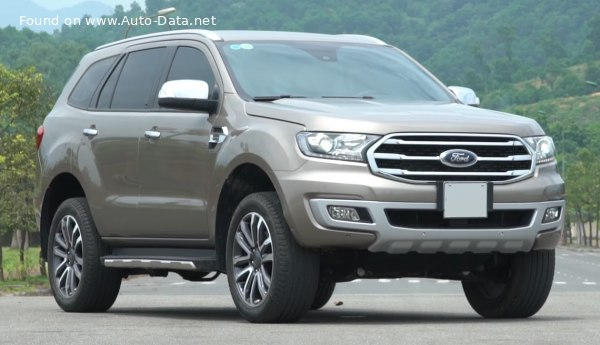

| What is the body type, Ford Everest II (U375/UA, facelift 2018)? | SUV, 5 Doors, 7 Seats |
|---|---|
| What is the fuel economy, Ford Everest II (U375/UA, facelift 2018) 3.2 DuratorqTDCi (194 Hp) Automatic 7 Seat? | 8.4 l/100 km 28 US mpg 33.63 UK mpg 11.9 km/l |
| How ECO is the car, Ford Everest 3.2 DuratorqTDCi (194 Hp) Automatic 7 Seat? | 221 g/km CO2 |
| How much power, Ford Everest SUV 2018 3.2 DuratorqTDCi (194 Hp) Automatic 7 Seat? | 194 Hp, 470 Nm 346.65 lb.-ft. |
| What is the engine size, Ford Everest SUV 2018 3.2 DuratorqTDCi (194 Hp) Automatic 7 Seat? | 3.2 l 3198 cm3 195.15 cu. in. |
| How many cylinders, 2018 Ford 3.2 DuratorqTDCi (194 Hp) Automatic 7 Seat? | 5, Inline |
| What is the drivetrain, Ford Everest II (U375/UA, facelift 2018) SUV 2018 3.2 DuratorqTDCi (194 Hp) Automatic 7 Seat? | Rear wheel drive. Internal Combustion engine. The Internal combustion engine (ICE) drives the rear wheels of the vehicle. |
| How long is this vehicle, 2018 Ford Everest SUV? | 4903 mm 193.03 in. |
| How wide is the vehicle, 2018 Ford Everest SUV? | 1869 mm 73.58 in. |
| What is the curb weight, 2018 Ford Everest II (U375/UA, facelift 2018) 3.2 DuratorqTDCi (194 Hp) Automatic 7 Seat? | 2283 kg 5033.15 lbs. |
| What is the gross weight, 2018 Ford Everest II (U375/UA, facelift 2018) 3.2 DuratorqTDCi (194 Hp) Automatic 7 Seat? | 2950 kg 6503.64 lbs. |
| How much trunk (boot) space, 2018 Ford Everest SUV? | 450 - 2010 l 15.89 - 70.98 cu. ft. |
| How many gears, What type is the gearbox, 2018 Ford Everest II (U375/UA, facelift 2018) 3.2 DuratorqTDCi (194 Hp) Automatic 7 Seat? | 6, automatic transmission |
| General information | |
|---|---|
| Brand | Ford |
| Model | Everest |
| Generation | Everest II (U375/UA, facelift 2018) |
| Modification (Engine) | 3.2 DuratorqTDCi (194 Hp) Automatic 7 Seat |
| Start of production | May, 2018 year |
| End of production | September, 2022 year |
| Powertrain Architecture | Internal Combustion engine |
| Body type | SUV |
| Seats | 7 |
| Doors | 5 |
| Performance specs | |
| Fuel consumption (economy) - combined | 8.4 l/100 km
28 US mpg 33.63 UK mpg 11.9 km/l |
| CO2 emissions | 221 g/km |
| Fuel Type | Diesel |
| Weight-to-power ratio | 11.8 kg/Hp, 85 Hp/tonne |
| Weight-to-torque ratio | 4.9 kg/Nm, 205.9 Nm/tonne |
| Engine specs | |
| Power | 194 Hp @ 3000 rpm. |
| Power per litre | 60.7 Hp/l |
| Torque | 470 Nm @ 1750-2500 rpm. 346.65 lb.-ft. @ 1750-2500 rpm. |
| Engine layout | Front, Longitudinal |
| Engine displacement | 3198 cm3 195.15 cu. in. |
| Number of cylinders | 5 |
| Engine configuration | Inline |
| Cylinder Bore | 89.9 mm 3.54 in. |
| Piston Stroke | 100.76 mm 3.97 in. |
| Number of valves per cylinder | 4 |
| Fuel injection system | Diesel Commonrail |
| Engine aspiration | Turbocharger, Intercooler |
| Engine oil capacity | 8.91 l 9.42 US qt | 7.84 UK qt |
| Engine oil specification |  Log in to see. Log in to see. |
| Coolant | 13.3 l 14.05 US qt | 11.7 UK qt |
| Space, Volume and weights | |
| Kerb Weight | 2283 kg 5033.15 lbs. |
| Max. weight | 2950 kg 6503.64 lbs. |
| Max load | 667 kg 1470.48 lbs. |
| Trunk (boot) space - minimum | 450 l 15.89 cu. ft. |
| Trunk (boot) space - maximum | 2010 l 70.98 cu. ft. |
| Fuel tank capacity | 80 l 21.13 US gal | 17.6 UK gal |
| Permitted trailer load with brakes (12%) | 3000 kg 6613.87 lbs. |
| Dimensions | |
| Length | 4903 mm 193.03 in. |
| Width | 1869 mm 73.58 in. |
| Width including mirrors | 2180 mm 85.83 in. |
| Height | 1837 mm 72.32 in. |
| Wheelbase | 2850 mm 112.2 in. |
| Front track | 1560 mm 61.42 in. |
| Rear (Back) track | 1564 mm 61.57 in. |
| Front overhang | 916 mm 36.06 in. |
| Rear overhang | 1137 mm 44.76 in. |
| Ride height (ground clearance) | 227 mm 8.94 in. |
| Minimum turning circle (turning diameter) | 11.7 m 38.39 ft. |
| Approach angle | 29.5° |
| Departure angle | 25° |
| Ramp-over (brakeover) angle | 21.5° |
| Wading depth | 800 mm 31.5 in. |
| Drivetrain, brakes and suspension specs | |
| Drivetrain Architecture | The Internal combustion engine (ICE) drives the rear wheels of the vehicle. |
| Drive wheel | Rear wheel drive |
| Number of gears and type of gearbox | 6 gears, automatic transmission |
| Front suspension | Independent coil spring |
| Rear suspension | dependent spring suspension |
| Front brakes | Ventilated discs |
| Rear brakes | Disc |
| Assisting systems | ABS (Anti-lock braking system) |
| Steering type | Steering rack and pinion |
| Power steering | Electric Steering |